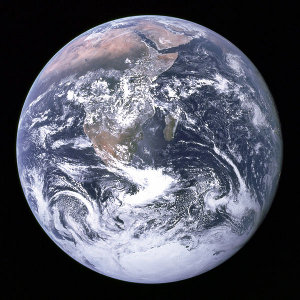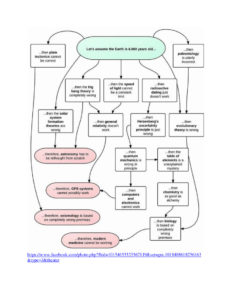Creation Corner
Earth is 7000 years old. So?

On or about Monday 18 September 2017, someone published a graphic on Facebook. He titled it “Let’s assume the Earth is 6000 years old.” But he forgot to share it beyond his group. (For that reason, this correspondent will not give an original link.) Another member of that group downloaded the photograph and shared it with this correspondent. No doubt the group member did this to heap scorn on creation. Nevertheless the graphic—a logical flow chart—gives valuable insight into what secularists think about the origins of the universe, the earth, and life. That gives it value beyond—and opposite—the propaganda value the composer hoped to achieve.
Flow chart of what follows from a young Earth
The chart lists seven specific things that follow from a young Earth. It then lists other things that follow from those five. From these it identifies a total of four “last things” that follow, that either:
- Have dire implications for science or human society, or
- Fall before obvious counterexamples.
The Creation Science Hall of Fame disputes those notions. Your correspondent will now tear to tatters this logically fallacious tapestry. To do this, this correspondent will examine each immediate consequence, in the order in which the graphic presents them.
Before beginning, this correspondent will change 6000 years to 7000. Why 7000? Because evidence from observation, and statistical analysis of same, shows the Global Flood happened 5300 years ago, give or take 100. Creation happened about 1600 years earlier than that, give or take fifty or sixty. So the best assumption for the age of the earth is not 6000, but 7000 years. Let us see, then, what really follows if the Earth is 7000 years old.
Plate tectonics
“If the Earth is young, then plate tectonics cannot be correct. And if plate tectonics is incorrect, then seismology has completely wrong premises as its basis.”
Any student of formal logic soon learns: if any of one’s premises are false, that means only that they cannot reliably support a given conclusion. The conclusion might still be true or false.
The author of the graphic assumes without warrant that nothing would happen as seismology says it will, if seismology proceeds on false premises. That’s an elementary logical fallacy. The inverse of a logical statement is not necessarily true merely because the statement itself is true.
Hydroplate Theory v. Classic Plate Tectonics
In fact, the Hydroplate Theory of the Global Flood predicts many of the same things conventional theory predicts. But it also predicts much that conventional theory does not predict. As evidence, Walter T. Brown Jr., who formed the theory, gives us this synoptic table of the evidence demanding an explanation, and how well the Hydroplate Theory and conventional plate tectonics explains each detail.
Notice! With but two exceptions (images of the Earth’s interior, and earthquakes occurring at low tide), geological observations relating to earthquakes are deal-killers for plate tectonics. So the premise of the argument already fails. Plate tectonics fails, not because the earth is young, but because it cannot explain what we observe.
As to the two exceptions, the Hydroplate Theory explains them far more easily than does plate tectonics. On the other hand, the Hydroplate Theory has trouble explaining two other observations. Why do we see water in the upper mantle, or continental material under the ocean floor? But with whatever difficulty the Hydroplate Theory can explain these things, plate tectonics cannot explain them at all.
In fact, Brown told this correspondent something long ago about earthquakes. Every earthquake we feel today is an aftershock of the tremendous earthquakes that attended the Global Flood. More to the point: what does the Hydroplate Theory tell us about what is to come? In fact, metals, below a certain depth, are draining into the outer core of Earth. This core is therefore coming under greater pressure as time passes. “Sooner or later,” Dr. Brown told this correspondent, “something’s got to give!” Turn now to Revelation 6:12-17. What do these verses describe? A generalized earthquake! Exactly what one expects with an expansion of the outer core. Plate tectonics does not predict this.
Formation of the solar system
As well as contradicting plate tectonics, a young Earth also contradicts the Nebula Theory of formation of the solar system. According to this theory, dust clouds from two or three supernovae somehow collide, then accrete. The resulting giant nebula thus collapses under its own weight. As it collapses, it spins, A new star forms first, then planets, then satellites of planets. Meteoroids, asteroids, comets, and objects beyond a certain limit form from whatever the process “leaves over.”
Actually, astronomers cannot even agree on how comets form. The Hydroplate Theory competes with no fewer than six rival theories. This synoptic table lists them all—and the deal-killers against each.
Asteroids present a worse problem for conventional astronomy. How can an asteroid capture a moon? Yet asteroids with moons do exist.
The Hydroplate Theory makes one radical assertion in this context. Every trans-Neptunian object formed from material that escaped Earth during the Global Flood. That sounds impossible but in fact will work. The total mass of:
- Meteoroids,
- Comets,
- Asteroids,
- All trans-Neptunian objects, including dwarf planets like Pluto and Eris,
- The two moons of Mars,
- Every moon of Jupiter aside from the Galileans,
- All the moons of Saturn aside from Titan,
- Every moon of Uranus and Neptune, and
- The entire substance of the rings of Saturn and all the other gas giants,
amounts to less than four percent of the current mass of the Earth.
Other Solar system deal-killers
On the other hand: every planet in the Solar System, and the Moon of Earth, present deal-killers for the Nebula Theory. For example: why does Venus spin backwards in relation to the Sun, the Earth, and most other planets? Why does Uranus roll on its side—and all its moons revolve around it in the plane of its equator, or close to it? Why didn’t Mercury or Venus form with moons? The Sun itself presents another problem: it spins too slowly for this model to predict. That slow spin violates the Law of Conservation of Angular Momentum.
Our own Solar System presents enough problems for the Nebula Theory. Extrasolar planets present worse problems. Many of these orbit much closer to their primaries than are planets of comparable size in our system. In fact they orbit too close to have formed. The forming sun would have vaporized any “planetesimals” that formed so close.
The graphic artist despairs for modern astronomy. He says a young Earth would force a complete re-examination of all of astronomy. So what? The sun will still set tonight and rise tomorrow. The recent Total Eclipse of the Sun tells us the Moon still exists. So why does the graphic artist worry?
A Big Bang or a Big Stretch?
The artist correctly identifies another consequence: the Big Bang theory does not work for a young Earth. Again the artist says that forces us to re-examine all of modern astronomy. Furthermore he says Einsteinian General Relativity would not work. That, in turn, would mean the Global Positioning System could not work. Yet it does.
Not to worry! The General Theory of Relativity explains local effects only. The Big Bang is an attempt to explain the history of the entire universe. It does not affect us every day where we live. Global positioning can still work.
Nevertheless, the Big Bang is not correct. The problem: Einstein’s General Relativity does not reliably work across the whole universe. A universe needs its own theory of relativity to explain it. John Hartnett and Moshe Carmeli, in 2007, provided one: cosmological relativity. This theory treats the speed of recession of large objects from our Galaxy as another dimension. And: it predicts the apparent acceleration of universal expansion, and the high spin rate of large, far-off objects. It does this without the mathematical fudges of “dark energy” and “dark matter.” In fact, Dr. Carmeli correctly predicted an apparent acceleration of the universe before cosmologists first discovered it. But those cosmologists then invented “dark energy” to explain it.
The speed of light problem
The artist also denies that the speed of light in a vacuum can be constant if the earth is only 7000 years old. He assumes without warrant that all objects in the universe “age” at the same rate. Even Einstein said objects in a gravity field age more slowly than do objects not within one.
The Earth is 7000 years old by any clock on Earth. That does not mean the cosmos would be 7000 years old no matter where one set a clock. A clock at the edge of the universe would measure the age of that edge at 13.7 billion years.
Why the difference? Because space did not blow up, as the Big Bang implies. Something—or rather, some-One—stretched space. The Bible attests to this Big Stretch in at least three places. Hartnett calculates that the Big Stretch would in fact allow Adam to see the same stars we see today. The Stretch does not cut off the light that has already emanated from the stars.
This illustrates another thing secular astronomers won’t admit. The Galaxy lies at the center of the universe. The angular momentum vector of the Galaxy lines up with the angular momentum vector of the universe.
This of course breaks the Hubble Principle, which Edwin Hubble misnamed the Copernican Principle.
An unwelcome hypothesis?
According to this, the universe has no center. Read Edwin Hubble’s own words:
The assumption of uniformity has much to be said in its favour. If the distribution were not uniform, it would either increase with distance, or decrease. But we would not expect to find a distribution in which the density increases with distance, symmetrically in all directions. Such a condition would imply that we occupy a unique position in the universe, analogous, in a sense, to the ancient conception of a central earth. The hypothesis cannot be disproved but it is unwelcome and would be accepted only as a last resort in order to save the phenomena. Therefore, we disregard this possibility and consider the alternative, namely, a distribution which thins out with distance.
Unwelcome? And though he cannot disprove it, he willfully discards it? What an arrogant “wild donkey” of a man was this Edwin Hubble, to be sure! A more humble astronomer would in fact admit we do “occupy a unique position in the universe.” We are the center of Divine Attention—and our Galaxy, symbolic of that, lies at the center of the universe.
Barry Setterfield, on the other hand, assumes light traveled far faster originally than it does today. Other cosmologists, especially Hartnett and Carmeli, dispute him on this. But even if he has the correct answer, he never said light slows down today enough to notice. So nothing threatens the GPS system. It is as accurate as it must be to serve the needs of modern civilization. If those needs demand greater accuracy than we see today, we’ll find that out soon enough. (But we’ll likely not find it out before the Second Coming of Christ.)
Radiometric dating
Obviously a young Earth contradicts radiometric and other dates saying the Earth is far older. But the graphic artist then makes risible claims about where this leads. Specifically he says any challenge to radiometric dating, breaks the Heisenberg Uncertainty Principle. And without Heisenberg’s Uncertainty, we don’t have quantum mechanics. If that fails, then electronics—using electricity to store and share information—cannot work. (That also would crash the GPS system.) Furthermore, he says, the Periodic Table of the Elements would beg explanation. “Then chemistry is as good as alchemy, then biology [follows] wrong premises, [and therefore] modern medicine cannot be working.”
Assuming facts not in evidence
His argument assumes many facts he does not place in evidence. Neither has anyone else placed such “facts” in evidence. Radiometric dating assumes:
- All radioactive elements formed with or before the earth and the Solar system. Specifically, they formed in the hearts of supernovae.
- All radioactive minerals form with zero daughter nuclide in all decay series. That is, they form with original “mother” nuclides only.
- Nothing adds to or subtracts from the concentration of any nuclide, other than radioactive decay.
- All radioactive decay proceeds at rates, the averages of which stay the same over time.
Why averages? Because we now know that all radioactive substances decay slightly faster when the Earth is at perihelion than when it is at aphelion. The Sun radiates neutrinos, and neutrinos affect radioactive decay. As the Earth moves closer to the Sun, radioactive decay accelerates in all series. But this change reverses itself as the Earth moves farther away. So the average should stay the same, if conventional assumptions hold.
But suppose radioactive elements formed after Creation, not before it? Suppose, furthermore, that these elements formed under circumstances that would accelerate nuclear decay temporarily. Wouldn’t that force people to re-examine the premises of radioactive decay? Wouldn’t it also leave the Heisenberg Uncertainty Principle alone?
Radioactivity from the Global Flood
In fact, the Hydroplate Theory (see above) can explain that, too. The earth’s crust contains abundant quartz. Quartz forms in an oxidizing atmosphere, like ours. Anything that deforms quartz, will then produce an electric current. Electrical engineers call this piezoelectricity—electricity under pressure.
The Global Flood provoked earthquakes of magnitudes that never happened before or since. The deformation of the quartz at these sites produced electromotive potentials strong enough to form plasma. Plasma consists of atomic nuclei without their electrons, and free electrons. Plasma can fuse, even when the nuclides involved don’t normally fuse. So heavy metals, now plasma, fused to form super-heavy nuclides. The nuclide unoctoctium, Z = 188, likely formed most abundantly. It split to form the abundances of uranium, thorium, and carbon-14 we see today. Because we see thorium three times as abundant as uranium, perhaps another nuclide, unoctohexium, Z = 186, formed and split into two parts thorium to one part carbon-14. Other super-heavy nuclides likely formed and made their own contributions.
In this highly charged environment, all radionuclides would decay faster than they do today. Robert Gentry noticed this, in the form of pleiochroic halos in rocks holding decayed minerals.
All this fusion, fission, and cluster decay produced “a sea of neutrons,” according to Brown. The still-escaping waters of the subcrustal ocean absorbed most of these. For that reason, deuterium—heavy hydrogen—is about twice as abundant in cometary and asteroidal ices than in the oceans of Earth. But other, lighter elements absorbed more neutrons. Result: heavy isotopes, some radioactive, others stable. Those isotopes, finding their way into animal and vegetable protein, would cause those proteins to mis-conform. That in turn would contribute to accelerated aging. The Bible tells us the longevity of human beings declined ninety percent in eleven generations.
Evidence for faulty dating
Have we evidence that radiometric dating is less than accurate? Yes. Steven A. Austin and colleagues found (1996) samples of dacite from the Mount Saint Helens lava dome showing preposterous ages. These ages varied from half a million to 2.8 million years. Yet the dome formed a mere ten years earlier. Later attempts to explain this discrepancy do not satisfy. They amount to a losing team crying “Foul!” without grounds. (Geochron Laboratories, which reported these wildly discrepant results, no longer performs potassium-argon dating.)
Later that year, Andrew A. Snelling published his finding from 1993. Radiometric dates of fossilized wood showed it to be 37,000 years old. This contrasted sharply (to say the least) with the apparent age of the surrounding basalt. That “dated” at over a million years old! Critics insist he should never have tried to date the wood itself, considering where he found it. That implies that any fossil which one tried to date from its own material would be apparently younger than the surrounding rock. Just so.
So now we have evidence that radiometric dating does not work, independent of any assertion of a young Earth. We also have an alternative theory that protects the Heisenberg Uncertainty Principle and everything that depends on it.
Paleontology (and the rest of evolution)
Yes, a 7000-year-old earth contradicts conventional paleontology, and conventional evolution. These conventional sciences all speak of a 4.5-billion-year-old Earth. Evolution—and more particularly the common descent principle—tells us all of life derives from one ancestral species. Obviously, to change from that one ancestor to the dizzying variety of life forms we see today, takes time. Vast intervals of time. Deep time, as evolutionists call it. Without these principles, we have no biology—and hence no modern medicine.
First, modern medicine does not depend, and never depended, on the idea that all life derives from one ancestral species or population. Modern medicine works as well as it does, because all of life has common design elements. Life did not spring into being from non-life. Someone—namely, God—designed life. We see the common design elements all around us, as “homologous structures.”
Second, modern allopathic medicine does not work nearly as well as its proponents boast.
Sadly, “Skid Marks Disease” finds its direct analogue in many conditions known to rheumatology, a branch of internal medicine. These and other equally profound errors result when one messes with the Work of the Master. To be fair, at least some alternative medical practitioners, like Joseph R. Mercola, D.O., reach their conclusions in another way: don’t mess with a system that has stood the test of deep time. Dr. Mercola in fact illustrates a fundamental contradiction in allopathic medicine. They say they respect the notion that life “evolved” over “deep time.” Yet they dare propose interventions that take no account of this “deep time.” Let the evolutionists get their stories straight!
Accelerated time
Third, we have direct evidence that time was never as “deep” as evolutionists insist. Out-of-place Artifacts (OOParts) tell us that certain strata are in fact far more recent. In fact they tell us that civilization had advanced further than one supposes, before the Global Flood.
Fourth and last: modern baraminologists (scientists who study the “created kinds” of life) now know new species can arise from the original kinds faster than any conventional paleontologist thought they could. They can arise fast enough, in fact, to have repopulated the Earth after the ancestral specimens disembarked from the Ark. The creation of multiple ancestral forms, and the rapid speciation since the Flood, both agree with a young Earth.
Conclusion
So a young Earth, say 7,000 years old (give or take a hundred), does not contradict observable fact or how things work today. Astronomy might indeed need re-examination. But seismology, global positioning, and modern medicine still work as well as humans need them to work. And astronomy can only benefit from the re-examination a young earth might prompt.
Terry A. Hurlbut has been a student of politics, philosophy, and science for more than 35 years. He is a graduate of Yale College and has served as a physician-level laboratory administrator in a 250-bed community hospital. He also is a serious student of the Bible, is conversant in its two primary original languages, and has followed the creation-science movement closely since 1993.
-

 Civilization5 days ago
Civilization5 days agoIlhan Omar Did Not Flee From Oppression As A Refugee – She Was Fleeing Justice & Has Been Installed To Attack – This Video Speaks Loud & Clear
-

 Guest Columns4 days ago
Guest Columns4 days agoShe Saved Her Life. 7-Eleven Fired Her
-

 Civilization5 days ago
Civilization5 days agoThis Thanksgiving, Celebrate the New Beacon of the American Dream
-

 Civilization4 days ago
Civilization4 days agoDemocrats’ Viral Video Lights Match to the Republic
-

 Guest Columns3 days ago
Guest Columns3 days agoWaste of the Day: What’s Big, Grey And Costs $350K?
-

 Civilization3 days ago
Civilization3 days agoThe AI Challenge: Palantir, the Pope, and Paul Kingsnorth
-

 Civilization3 days ago
Civilization3 days agoNo Kings, No Queens, No Blind Loyalty
-

 Executive2 days ago
Executive2 days agoWaste of the Day: California’s $450 Million 911 Center Doesn’t Work














Very few people have the guts to admit they do not have all the facts. And admitting to “creationism” admit to a creator, and if a creator exists … one has to ask “why did the creator create me.” And many people don’t like those implications.
The diagram also has a series of serious logical fallacies as well. It makes assumptions that just because the earth is young what we observe is not accurate. Attempted explanations might be wrong even though the observation seen are described accurately. Consider “plate tectonics”. When the theory was proposed it was attacked by the scientists of the time because it was inconvenient. There is a difference between a “theory” and a “theorem”. A theory is unproven conjuncture created based upon observations. A theorem is something that has been proven. The diagram is loaded with meaningless assumptions where something has been ASSUMED to be true. The eruption of Mount St Helen’s undermined all sorts of assumed science that people don’t want to admit to – such as radioactive dating. It is inconvenient to many people and their agenda, as well as to their ego and source of money. The diagram is also an attempt to avoid admitting that flawed explanations are flawed explanations by deflecting attention that the flawed explanations are flawed.
You are correct, Don. On both counts. Yes, once one admits to creation, one must admit to a Creator. Who in turn expects certain things of you. Things some people don’t want to deliver, and other things from which those same people don’t want to refrain.
And yes, the whole point of my article is that the diagram assumes incorrectly that any logical statement and its inverse (or converse) are simultaneously true or false. That is, if p implies q, then not-p implies not-q. It doesn’t work that way. I simply put in other explanations for all the processes we now have available. And also pointed out that some things, like modern allopathic medicine, do not work nearly as well as evolutionists think they do.
With regard to allopathic medicine: allopathic medicine violates the basic priniciples the evolutionists rely upon. Joe Mercola (who did the video) recognizes that. “Don’t mess with what has stood the test of Deep Time!” he says. I say, “Don’t mess with the work of the Master.” It gives most of the same answers.